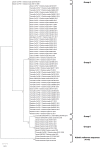Molecular evidence for horizontal transmission of chelonid alphaherpesvirus 5 at green turtle (Chelonia mydas) foraging grounds in Queensland, Australia
- PMID: 31917785
- PMCID: PMC6952114
- DOI: 10.1371/journal.pone.0227268
Molecular evidence for horizontal transmission of chelonid alphaherpesvirus 5 at green turtle (Chelonia mydas) foraging grounds in Queensland, Australia
Abstract
Fibropapillomatosis (FP) is a marine turtle disease recognised by benign tumours on the skin, eyes, shell, oral cavity and/or viscera. Despite being a globally distributed disease that affects an endangered species, research on FP and its likely causative agent chelonid alphaherpesvirus 5 (ChHV5) in Australia is limited. Here we present improved molecular assays developed for detection of ChHV5, in combination with a robust molecular and phylogenetic analysis of ChHV5 variants. This approach utilised a multi-gene assay to detect ChHV5 in all FP tumors sampled from 62 marine turtles found at six foraging grounds along the Great Barrier Reef. Six distinct variants of ChHV5 were identified and the distribution of these variants was associated with host foraging ground. Conversely, no association between host genetic origin and ChHV5 viral variant was found. Together this evidence supports the hypothesis that marine turtles undergo horizontal transmission of ChHV5 at foraging grounds and are unlikely to be contracting the disease at rookeries, either during mating or vertically from parent to offspring.
Conflict of interest statement
The authors have declared that no competing interests exist.
Figures




Similar articles
-
Examining the Role of Transmission of Chelonid Alphaherpesvirus 5.Ecohealth. 2017 Sep;14(3):530-541. doi: 10.1007/s10393-017-1248-7. Epub 2017 May 16. Ecohealth. 2017. PMID: 28512730
-
Phylogenetic Variation of Chelonid Alphaherpesvirus 5 (ChHV5) in Populations of Green Turtles Chelonia mydas along the Queensland Coast, Australia.J Aquat Anim Health. 2017 Sep;29(3):150-157. doi: 10.1080/08997659.2017.1330783. J Aquat Anim Health. 2017. PMID: 28524816
-
Differences in Antibody Responses against Chelonid Alphaherpesvirus 5 (ChHV5) Suggest Differences in Virus Biology in ChHV5-Seropositive Green Turtles from Hawaii and ChHV5-Seropositive Green Turtles from Florida.J Virol. 2020 Jan 31;94(4):e01658-19. doi: 10.1128/JVI.01658-19. Print 2020 Jan 31. J Virol. 2020. PMID: 31748397 Free PMC article.
-
A review of fibropapillomatosis in Green turtles (Chelonia mydas).Vet J. 2016 Jun;212:48-57. doi: 10.1016/j.tvjl.2015.10.041. Epub 2015 Oct 21. Vet J. 2016. PMID: 27256025 Review.
-
Epidemiology of marine turtle fibropapillomatosis and tumour-associated chelonid alphaherpesvirus 5 (ChHV5; Scutavirus chelonidalpha5) in North-Western Mexico: a scoping review implementing the one health approach.Vet Res Commun. 2024 Oct;48(5):2943-2961. doi: 10.1007/s11259-024-10429-6. Epub 2024 Jun 26. Vet Res Commun. 2024. PMID: 38922387 Free PMC article.
Cited by
-
Transcriptomic Profiling of Fibropapillomatosis in Green Sea Turtles (Chelonia mydas) From South Texas.Front Immunol. 2021 Feb 24;12:630988. doi: 10.3389/fimmu.2021.630988. eCollection 2021. Front Immunol. 2021. PMID: 33717164 Free PMC article.
-
Environmental DNA monitoring of oncogenic viral shedding and genomic profiling of sea turtle fibropapillomatosis reveals unusual viral dynamics.Commun Biol. 2021 May 12;4(1):565. doi: 10.1038/s42003-021-02085-2. Commun Biol. 2021. PMID: 33980988 Free PMC article.
-
Insights on Immune Function in Free-Ranging Green Sea Turtles (Chelonia mydas) with and without Fibropapillomatosis.Animals (Basel). 2021 Mar 18;11(3):861. doi: 10.3390/ani11030861. Animals (Basel). 2021. PMID: 33803547 Free PMC article.
-
The Concurrent Detection of Chelonid Alphaherpesvirus 5 and Chelonia mydas Papillomavirus 1 in Tumoured and Non-Tumoured Green Turtles.Animals (Basel). 2021 Mar 5;11(3):697. doi: 10.3390/ani11030697. Animals (Basel). 2021. PMID: 33807588 Free PMC article.
-
Increased Prevalence and New Evidence of Multi-Species Chelonid Herpesvirus 5 (ChHV5) Infection in the Sea Turtles of Mabul Island, Borneo.Animals (Basel). 2023 Jan 14;13(2):290. doi: 10.3390/ani13020290. Animals (Basel). 2023. PMID: 36670830 Free PMC article.
References
-
- Herbst LH. Fibropapillomatosis of marine turtles. Annual Review of Fish Diseases. 1994;4:389–425. 10.1016/0959-8030(94)90037-X - DOI
-
- Aguirre AA, Balazs GH, Spraker TR, Gross TS. Adrenal and Hematological Responses to Stress in Juvenile Green Turtles (Chelonia mydas) with and without Fibropapillomas. Physiological Zoology. 1995;68(5):831–54.
MeSH terms
Substances
LinkOut - more resources
Full Text Sources

